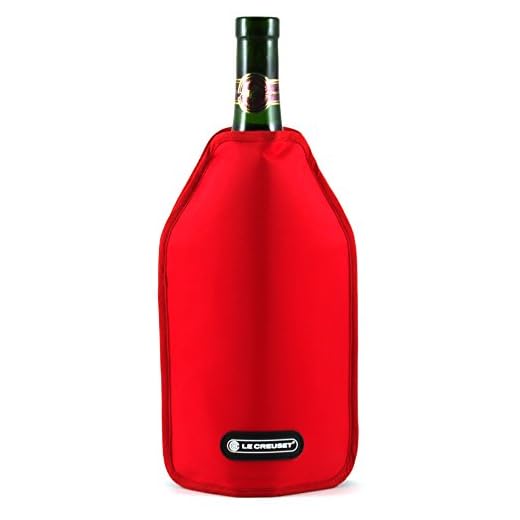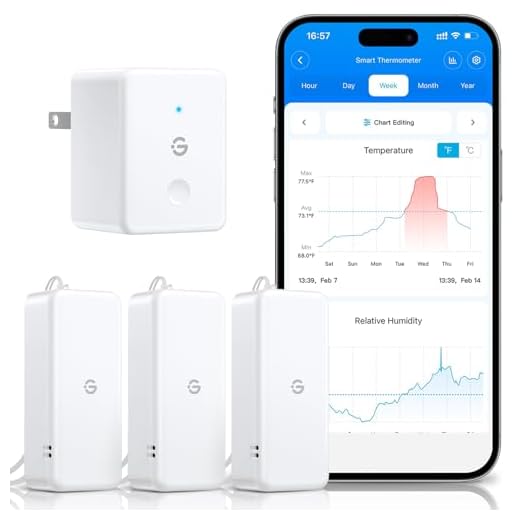



Serving these beverages at a temperature between 45°F and 50°F (7°C to 10°C) enhances their refreshing qualities and brings out the delicate flavors and aromas. This temperature range allows the acidity and fruitiness to shine, creating a more enjoyable tasting experience.
For those seeking to elevate their enjoyment, consider placing the bottle in an ice bucket filled with a mix of ice and water for approximately 20 minutes prior to serving. This method ensures an even and consistent chill, avoiding the risk of overcooling that can mute the wine’s character.
Pay attention to the specific varietal you’re enjoying. Lighter options, such as Sauvignon Blanc and Pinot Grigio, benefit from this cooler serving temperature, while fuller-bodied selections like Chardonnay can be served slightly warmer, around 50°F to 55°F (10°C to 13°C), to enhance their creamy textures and complex flavors.
Experimenting with temperature can unlock new dimensions in your tasting journey, allowing you to appreciate the nuances of each bottle. Always trust your palate; the best temperature is the one that brings you the most pleasure.
Should White Wine Be Chilled?
Serving this beverage at an ideal temperature enhances its aroma and flavor profile. Aim for a range between 45°F and 55°F (7°C to 13°C). This temperature allows for the crisp acidity and fruity notes to shine.
Here are some specific types and their optimal serving temperatures:
- Light-bodied varieties (e.g., Sauvignon Blanc, Pinot Grigio): 45°F – 50°F (7°C – 10°C)
- Medium-bodied selections (e.g., Chardonnay, Viognier): 50°F – 55°F (10°C – 13°C)
- Full-bodied options (e.g., Oak-aged Chardonnay): 55°F (13°C)
To achieve the right temperature quickly, consider these methods:
- Place the bottle in an ice bucket filled with equal parts ice and water for about 15-20 minutes.
- Refrigerate the bottle for 1.5 to 2 hours before serving.
- If time is short, a quick chill in the freezer for 30 minutes works in a pinch, but don’t forget it!
Temperature impacts not just taste but also the overall experience. Cooler temperatures often highlight the refreshing characteristics, while slightly warmer can bring out the complexity and depth. Experimentation is key to finding what works best for your palate.
Optimal Temperature Range for White Wine
The ideal serving temperature for light varieties is between 45°F and 50°F (7°C to 10°C). For fuller-bodied options, aim for 50°F to 55°F (10°C to 13°C). This range enhances the aromatic profile and balances acidity with flavor richness.
When serving, consider these specific guidelines:
- Light-bodied: Sauvignon Blanc, Pinot Grigio, and Vinho Verde benefit from the lower end of the spectrum.
- Medium-bodied: Chardonnay and Viognier thrive at slightly warmer temperatures.
- Full-bodied: Oaked Chardonnays and rich whites perform best when served closer to 55°F.
Use a thermometer to ensure accuracy, as a slight deviation can significantly impact the tasting experience. If you find the beverage too cold, let it sit for a few minutes before serving. Conversely, if it’s slightly warm, a brief chill in an ice bucket will help reach the desired temperature.
Understanding these nuances empowers you to elevate your tasting experience, allowing for a true appreciation of the complexities and characteristics inherent in each glass.
Impact of Chilling on Flavor Profile
Chilling significantly influences the taste and aroma of a beverage. When served cool, the refreshing nature of these drinks becomes more pronounced, enhancing fruity and floral notes. This temperature accentuates acidity, resulting in a crisper mouthfeel that many find appealing.
Flavor Complexity
At lower temperatures, some intricate flavors may be muted. For instance, buttery or oaky characteristics can diminish, leading to a lighter, more straightforward profile. If you prefer a rich and complex experience, slightly warmer serving temperatures may be beneficial. Experimenting within a range is key to discovering personal preferences.
Aromatics and Serving Temperature
The olfactory experience can transform based on temperature. Cooler drinks tend to mask some aromatic compounds, which might be desirable for those who lean towards a refreshing sip. However, if aromatic complexity is what you seek, consider allowing the drink to warm slightly in the glass. This balance can reveal hidden layers, offering a more rounded tasting experience.
For those enjoying outdoor activities, a portable solution like a best solar panel generator for camping can enhance your experience, keeping your drinks at the perfect temperature while you explore nature’s beauty.
Best Methods for Chilling White Wine
The quickest way to cool this beverage is through an ice bucket method. Fill a bucket with a 50/50 mix of ice and water, submerge the bottle, and within 15-20 minutes, you’ll achieve the ideal temperature. This method ensures even cooling, as water conducts cold better than air.
If time is of the essence, consider using a freezer. Wrap the bottle in a damp cloth and place it inside for about 20 minutes. The moisture aids in rapid cooling, thanks to the evaporation process. Just remember to set a timer to avoid freezing your drink.
An alternative technique involves using an insulated wine cooler. These devices maintain a consistent temperature and can bring your beverage down to optimal levels in about 30 minutes. Simply place the bottle inside and let the cooler do the work.
For a more hands-on approach, try a saltwater solution. Adding salt to ice water lowers the freezing point, allowing for even faster cooling. Just be sure to rinse the bottle before serving to remove any salt residue.
If you’re interested in a more leisurely method, place the bottle in the refrigerator for a few hours prior to serving. This is great for planning ahead and ensures your drink is perfectly refreshing without the risk of over-chilling.
Finally, consider investing in a wine chiller sleeve. These sleeves can be pre-frozen and then wrapped around the bottle, providing consistent cooling during your gathering. This is particularly useful for outdoor events or picnics.
Common Mistakes When Chilling White Wine
One of the biggest errors is using the freezer for rapid cooling. While it may seem convenient, leaving bottles in there for too long can lead to a frozen explosion or undesirable flavors. Instead, use an ice bucket with water and ice for more controlled chilling.
Another frequent mistake involves ignoring the bottle shape. Standard bottles chill more effectively than those with thicker glass or unique shapes. Ensure you position them for optimal contact with the chilling medium.
Serving temperature is often overlooked. Pouring directly from a cold bottle can mask the aromas and flavors. Allow it to sit for a moment after chilling, letting the temperature equilibrate before serving.
Overchilling and Its Effects
Many enthusiasts overchill their selections. Temperatures below 45°F can mute the subtleties of flavor, making them taste flat. Aim for a range of 45°F to 50°F to preserve the aromatic complexity.
Neglecting Timing
Lastly, timing is critical. Chilling for too short a period can lead to lukewarm servings, while excessive time in the ice bath can result in overly cold beverages. Monitor the clock; typically, 20-30 minutes in an ice bath is sufficient. Adjust based on the initial temperature of the bottle.
Pairings: Chilled vs. Non-Chilled
For optimal enjoyment, consider pairing temperature with food choices. When serving a refreshing Sauvignon Blanc or a crisp Pinot Grigio, keeping it cool heightens the acidity and enhances the zesty flavors, making these selections perfect alongside seafood, salads, or light pastas. The chilled state accentuates the citrus notes, complementing dishes like grilled shrimp or a fresh ceviche.
Conversely, serving a fuller-bodied option, such as a Viognier or an oaked Chardonnay, slightly warmer can bring out the rich, creamy textures and complex aromas. These wines shine when matched with roasted chicken, creamy sauces, or richer cheeses, as a warmer temperature allows the intricate flavors to unfold more fully.
Temperature and Flavor Integration
Each varietal reacts differently to temperature. A cool serving temperature can suppress the nuances in aromatic whites, making them feel more one-dimensional. In contrast, allowing a richer varietal to warm slightly can reveal layers of flavor, making it an excellent companion to heartier meals.
Practical Pairing Tips
When planning your pairings, consider serving lighter, crisper selections straight from the cooler. For fuller styles, aim for a slightly warmer serving temperature, around 50-55°F. This approach will not only elevate the flavors but also enhance the overall dining experience. Pay attention to the dish’s weight and seasoning to find the perfect match. Experimentation is key; adjust temperatures based on personal preference and the specific food pairing to discover what works best for you.
Regional Varieties and Their Chilling Preferences
Different regions produce distinct types of fermented grape beverages, each with unique flavor profiles and chilling needs. For example, crisp and aromatic selections from the Loire Valley benefit from lower temperatures, around 45°F to 50°F (7°C to 10°C), enhancing their fresh acidity and floral notes. In contrast, richer and more full-bodied varieties from California can be served slightly warmer, around 50°F to 55°F (10°C to 13°C), allowing their complex flavors to emerge without being masked by excessive coolness.
Temperature Recommendations by Region
| Region | Ideal Serving Temperature (°F) | Characteristics |
|---|---|---|
| Loire Valley | 45-50 | Crisp, floral, with high acidity |
| Bordeaux | 50-55 | Rich, textured, often oak-influenced |
| California | 50-55 | Full-bodied, fruit-forward, complex |
| Germany | 45-50 | Light, sweet, with vibrant acidity |
| Italy (Pinot Grigio) | 45-50 | Fresh, zesty, often mineral-driven |
Some Italian varieties, like Pinot Grigio, shine at cooler temperatures, emphasizing their crispness. Meanwhile, selections from Bordeaux, known for their elegance, can afford a slightly higher serving temperature to showcase their depth. This understanding allows for a more tailored approach to serving these beverages, ensuring each glass reflects its terroir and intended flavor experience.









